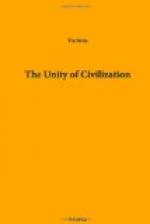BOOKS FOR REFERENCE
Merz, History of European Thought in the 19th Century. W. Blackwood.
Marvin, The Living Past. Clarendon Press.
VIII
THE UNITY OF WESTERN EDUCATION
I have been asked to address you on the Unity of Education in Western Europe. The task is not an easy one, for what do we mean by unity? It would be easy for me to spend my time in talking on the technical aspect of the subject; I could deal with curriculum and organization, with school buildings and class-rooms, black-boards, and all the material of schoolmastering, and could show you how great is the similarity in these matters in all civilized countries. I doubt, however, whether this would interest you; I doubt whether this is the unity of which you are in search. You would tell me that you asked for unity and I had given you uniformity. Uniformity you can have anywhere; in modern life all is standardized and stereotyped; you have it in the great hotel and the Atlantic liner—there you have men of all nations, they do the same thing at the same time, they eat the same food and wear the same clothes; you find it in the factory and on the battle-field. Go to a textile factory, whether in Oldham or in Chemnitz, or in Bombay, the processes are the same and the product is the same, except as there may be more or less adulteration.
And so in education, if you care to do so, you can find the mechanical uniformity of modern civilization. A new form of school-desk makes the round of the world as quickly as a new chemical process or a new battleship. The pictures on the walls of the rooms may be the reproduction of some modern German work, and the atlases you use may be second-rate copies of the products of Gotha or Leipzig; you can have, too, uniformity in time-table and curriculum; but, after all, this uniformity may be merely superficial. Go along the streets of an old town and you may see the regular facade of a modern street, but behind this you will find all the variety of the mediaeval buildings which it encloses—the facade is mere paint and stucco.
Uniformity is not necessarily unity, and unity is not inconsistent with variety. That which I presume we are searching for is a more fundamental, spiritual, and intellectual unity—internal not external; not a painted and stucco resemblance, but a unity of origin and of life.
Let us see what we can learn from history.
The history of European education is centred round two institutions, the School and the University. Both have their origin in the remote past, and both have maintained themselves with singular fidelity to their original type.




